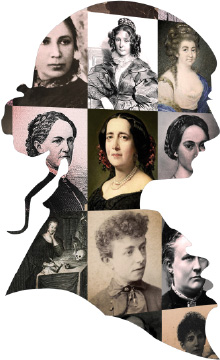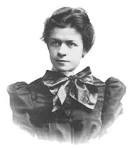Mileva Marić Einstein
1875–1948| Spouse | Albert Einstein |
|---|---|
| Date of birth | December 19, 1875 |
| Date of death | August 04, 1948 |
| Web address |
Personal situation
1875 - Scientist, researcher, mathematician and physicist Mileva Marić (married Einstein) was born in Titel (then Austro-Hungarian Empire) to affluent parents. The Marić family house at 20 Kisačka Street in Novi Sad is protected under the state law.
1886 - She starts attending the female gymnasium in Novi Sad.
1888 - She transfers to the gymnasium in Sremska Mitrovica, where she graduates in 1890 as the best in her class in mathematics and physics.
1890 - She attends the Royal Serbian School in Šabac. When she moved to Zagreb, she received a special permission to attend a boy’s school. Her father strongly supported her education despite the patriarchal pattern prevalent in the society.
1896 - In summer, she starts studying medicine at the University of Zurich. In October, she transferred to Zurich’s Polytechnic to study mathematics and physics, as the only woman in the Department of Physics and Mathematics. In the period between 1864 and 1872, some two hundred women from Switzerland, Germany, Austria, England, the USA and Russia attended the University of Zurich, speaking in favour of the university’s openness. It was there that the student from Kać met a colleague three years her junior, who later became her husband. We find out about the beginnings of this love relationship from the letters published in 1986. Einstein’s parents were against this relationship for two reasons: because Mileva was older than Albert and because she was not Jewish.
1902 - Mileva gives birth to their illegitimate daughter Lieserl, whose fate is unknown. Some speculate that the baby girl was given for adoption, while others believe that she probably died of scarlet fever.
1903 - After the wedding in Bern, Mileva dedicates herself completely to her husband and children. She gives birth to sons Hans Albert and Eduard, both of whom showed signs of mental illnesses. Having suffered from schizophrenia, Eduard died in 1965 in a Swiss asylum where his aunt, Mileva’s sister Zorka, died too. The scientific collaboration of the married couple is a controversial one. Mileva’s correspondence to Helene Savić (née Kauffler) and Milana Bota, as well as granddaughter Evelyn Einstein’s letters, published in 1922, speak in favour of Mileva’s scientific contribution to the theories of Albert Einstein.
1911 - The Einstein family moves to Prague, where Albert becomes full professor at Charles University. Mileva took some time to adapt, for she was sensitive to tensions between the German and the Czech, with whom, as a Slav, she identified.
1914 - Having secured a position at The Royal Prussian Academy of Sciences in Berlin and after a series of love affairs, including that with his cousin Elsa, Albert leaves Mileva, who stays in Zurich in poor health.
1919 - The Marić-Einstein couple is officially divorced on 14 February 1919.
1921 - Albert gives the money from the Nobel Prize to Mileva as a part of their divorce deal. Later, Mileva lived off private mathematics lessons.
1930 - In his early twenties, Eduard Einstein was diagnosed with schizophrenia.
1938 - Mileva’s sister Zorka dies. Mileva’s older son Hans Albert leaves for the USA, with his family. Mileva stays in Switzerland with her younger son.
1948 - Mileva dies from stroke in Zurich on August 4, 1948. She was buried at Nordheim Friedhod cemetery in Zurich. Her resting place became known to a wider public in 2004 thanks to Petar Stojanović, founder of the Nikola Tesla Memorial Centre in St. Gallen.
| Place of birth | Titel, Austrougarska |
|---|---|
| Place(s) of residence | Czech Republic, Germany, Serbia, and Switzerland |
| Place of death | Cirih, Švajcarska |
| Nationality | Serbian |
| First language(s) | German and Serbian |
| Marital status | Married |
| Number of children | 3 |
| Name(s) of children | Lizerl, Hans Albert, Eduard (Tete) |
| Gender of children | F(1) M(2) |
| Social class | Upper class |
| Education | University education |
Professional situation
1896 - Mileva Marić was the fifth woman admitted to Zurich’s Polytechnic (Eidgenössische Technische Hochschule Zürich). She spent a semester at Heidelberg, where she attended German physicist and Nobel Prize laureate Phillipp Eduard Anton von Lenard’s lectures.
1900 - Mileva’s performace at university begins to fade; she fails to graduate in her second attempt. Some seek reasons for this in her disagreement with Prof. Wilhelm Weber, but also in her emotional troubles.
1901 - Albert writes to Mileva, saying he will be happy once they finish their work on the theory of relativity. Her letters deal with everyday matters. It should be noted that of 54 saved letters, written in the period between 1897 and 1903, as much as 43 are by Albert, while only 11 are by Mileva.
1905 - Four Einstein’s articles, collectively known as Annus Mirabilis, are published in the scientific journal Annalen der Physik. Today these are considered the basis of modern physics. Russian physicist Abram Joffe claimed that in one of the articles published in 1905, last name Einstein-Marity – Marity (a spelling that does not appear anywhere else) probably being a Hungarian rendering of Marić – appeared along with Einstein. American physicist John Stachel claims that Einstein’s student-day letters where he speaks of “our theory” and “our work” predate 1905 by at least four years. Mileva’s friend, Milana Bota, claimed that Mileva actively participated in Einstein’s scientific work. Mileva and Albert’s son, Hans Albert, years after his parents’ deaths, stated in his letters that his mother helped his father with mathematical problems and calculations, noting that the creative part was Albert’s, although it is known that theory of relativity does not contain any important mathematical puzzles.
As for the feminist aspect of Mileva’s private correspondence, Svenka Savić analysed the discourse of the epistolary form in her text “Understanding Mileva Marić-Einstein: Private Letters”. Apart from letters addressed to her husband, relatives and friends, in a documentary produced by RTS (Radio Television of Serbia) - Educational-Scientific Program, namely, Mileva Einstein is mentioned as the author of two scientific works, in manuscript, on analytic mechanics and infrared radiation, the latter written in response to Max Planck.
1905 - In a letter to her friend Helene Savić, Mileva writes: “we have written a work that will make my husband famous in the whole world”. It is said that Mileva saw her relationship with Einstein, as well as her successes and scientific contributions, as “ein Stein” (one stone).
1915 - Considering Mileva and Albert’s split and the ensuing poor personal relations between former spouses, any possibility of Mileva’s scientific contribution after 1914 should be dismissed.
Sources:
Popović, Dragana. Žene u nauci: od Arhimeda do Ajnštajna: osvajanje osvojenog. Beograd: Službeni glasnik, 2012.
Savić, Svenka. “Put do Mileve Marić-Ajnštajn: privatna pisma”. Ženske studije, br. 4 (1996). Available at: http://www.zenskestudie.edu.rs/izdavastvo/elektronska-izdanja/casopis-zenske-studije/zenske-studije-br-4/245-put-do-mileve-maric-ajnstajn-privatna-pisma (accessed 13.4.2018).
"Istorija nauke: Mileva Marić Ajnštajn", Youtube Video, 11:00, 13. 5. 2015, RTS Obrazovno-naučni program - Zvanični kanal, https://www.youtube.com/watch?v=CDeqIPUqvbg
Wikipedia, available at: https://en.wikipedia.org/wiki/Mileva_Mari%C4%87
Translated by Višnja Krstić
| Profession(s) and other activities | scientist |
|---|---|
| Language(s) in which she wrote | German and Serbian |
Works by this author
Reception
Reception after death
Authors read by this author
* Only authors in Knjiženstvo DB are shown



